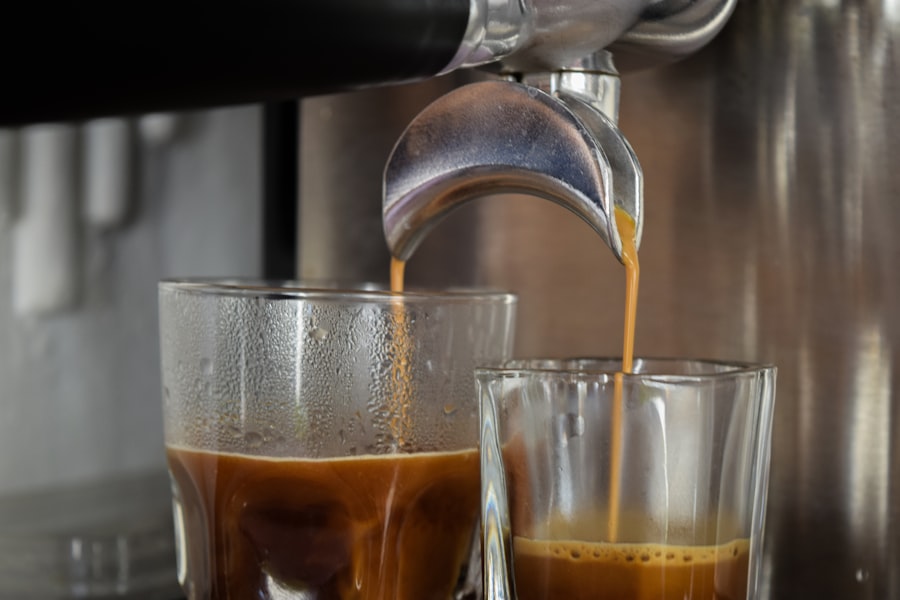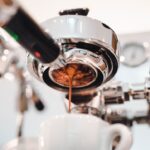The Cuisinart Thermal Coffee Maker has become a staple in many kitchens, celebrated for its ability to brew coffee that retains its warmth without the need for a hot plate. This innovative appliance is designed with a double-walled, vacuum-sealed thermal carafe that keeps coffee hot for hours, allowing coffee enthusiasts to enjoy their favorite brew at their leisure. Unlike traditional coffee makers that rely on a warming plate, which can scorch coffee and alter its flavor profile over time, the Cuisinart Thermal Coffee Maker preserves the integrity of the coffee, ensuring that each cup is as fresh and flavorful as the first.
This coffee maker is not just about keeping coffee warm; it also boasts a range of features that enhance the brewing experience. With programmable settings, users can wake up to the aroma of freshly brewed coffee, while the adjustable brew strength allows for customization according to personal taste preferences. The sleek design and user-friendly interface make it an attractive addition to any countertop, appealing to both novice brewers and seasoned coffee aficionados alike.
As we delve deeper into the intricacies of thermal brewing, it becomes clear that understanding the nuances of this process is essential for maximizing the potential of your Cuisinart Thermal Coffee Maker. Check out the benefits of fasting on your overall health and well-being.
Key Takeaways
- The Cuisinart Thermal Coffee Maker offers a convenient way to brew and enjoy flavorful coffee at home.
- Understanding the thermal brewing process is essential for achieving optimal taste and aroma in your coffee.
- Selecting the right coffee beans is crucial for achieving the best results in thermal brewing.
- Grinding techniques play a key role in maximizing flavor extraction from coffee beans.
- Water temperature and brewing time are important factors in achieving the optimal taste in your coffee.
Understanding the Thermal Brewing Process
The thermal brewing process is distinct from traditional methods primarily due to its reliance on a thermal carafe instead of a warming plate. When coffee is brewed in a thermal coffee maker, it is typically heated to an optimal brewing temperature of around 195°F to 205°F. This temperature range is crucial for extracting the full spectrum of flavors from the coffee grounds.
Once brewed, the coffee is immediately transferred to the insulated carafe, where it is kept hot through thermal insulation rather than direct heat. This method prevents over-extraction and bitterness that can occur when coffee sits on a hot plate for extended periods. Moreover, the thermal brewing process emphasizes the importance of brew time.
The ideal brewing time for most drip coffee makers is between four to six minutes, allowing for proper extraction without compromising flavor. The Cuisinart Thermal Coffee Maker is engineered to maintain this balance, ensuring that water flows through the coffee grounds at a consistent rate. This precision in brewing not only enhances flavor but also allows for a more nuanced tasting experience.
By understanding how thermal brewing works, users can appreciate the craftsmanship behind their Cuisinart and make informed decisions about their brewing techniques.
Selecting the Right Coffee Beans for Thermal Brewing

Choosing the right coffee beans is paramount when it comes to maximizing the flavor potential of your Cuisinart Thermal Coffee Maker. The type of beans you select can significantly influence the overall taste profile of your brew. For thermal brewing, it is advisable to opt for high-quality, freshly roasted beans.
Specialty coffee roasters often provide beans that are sourced from specific regions, each offering unique flavor notes influenced by factors such as altitude, climate, and processing methods. For instance, Ethiopian beans are known for their fruity and floral notes, while Colombian beans often present a balanced flavor with hints of caramel. In addition to selecting high-quality beans, freshness is key.
Coffee beans begin to lose their flavor shortly after roasting due to oxidation. To ensure maximum freshness, consider purchasing whole beans and grinding them just before brewing. This practice not only preserves the aromatic oils that contribute to flavor but also allows you to experiment with different roast levels and blends.
Light roasts tend to have brighter acidity and more pronounced flavors, while dark roasts offer deeper, bolder profiles. By understanding the characteristics of various beans and selecting those that align with your taste preferences, you can elevate your thermal brewing experience.
Grinding Techniques for Maximum Flavor Extraction
| Grinding Technique | Flavor Extraction |
|---|---|
| Coarse Grind | Less extraction, lighter flavor |
| Medium Grind | Moderate extraction, balanced flavor |
| Fine Grind | Higher extraction, stronger flavor |
The grind size of your coffee beans plays a crucial role in flavor extraction during the brewing process. For thermal brewing in a Cuisinart Coffee Maker, a medium grind is generally recommended. This grind size strikes a balance between allowing water to flow through the grounds efficiently while still providing enough surface area for optimal extraction.
If the grind is too coarse, water will pass through too quickly, resulting in under-extraction and a weak cup of coffee. Conversely, if the grind is too fine, it can lead to over-extraction, producing bitter flavors. Investing in a quality burr grinder can make a significant difference in achieving a consistent grind size.
Burr grinders crush beans between two revolving surfaces, allowing for uniformity in particle size, which is essential for even extraction. Additionally, experimenting with different grind sizes can yield varying flavor profiles; for instance, slightly adjusting the grind size can enhance or mellow certain tasting notes in your coffee. By mastering grinding techniques and understanding their impact on flavor extraction, you can unlock new dimensions of taste in every cup brewed with your Cuisinart Thermal Coffee Maker.
Water Temperature and Brewing Time for Optimal Taste
Water temperature and brewing time are critical factors that influence the extraction process in coffee brewing. For optimal taste in your Cuisinart Thermal Coffee Maker, water should be heated to a temperature between 195°F and 205°F. This range is ideal for extracting soluble compounds from coffee grounds without causing bitterness or undesirable flavors.
Most modern thermal coffee makers are designed to reach this temperature range automatically; however, using a thermometer can help ensure accuracy if you’re experimenting with different brewing methods. Brewing time also plays an essential role in flavor development. The general guideline for drip coffee makers is to aim for a brew time of four to six minutes.
During this period, water should be in contact with the coffee grounds long enough to extract essential oils and flavors without over-extracting bitter compounds. If you find that your coffee tastes weak or lacks depth, consider extending the brew time slightly or adjusting your grind size to achieve better extraction. Conversely, if your coffee tastes overly bitter or harsh, reducing the brew time or using a coarser grind may help balance the flavors.
Maintenance and Cleaning Tips for Prolonging Flavor Quality

To ensure that your Cuisinart Thermal Coffee Maker continues to produce delicious coffee over time, regular maintenance and cleaning are essential. Coffee oils and residue can build up within the machine and affect both flavor and performance if not addressed promptly. A simple yet effective cleaning routine involves rinsing out the carafe and filter basket after each use to remove any leftover grounds or oils.
Additionally, it’s advisable to run a mixture of equal parts water and white vinegar through the machine every few months to descale any mineral buildup that may occur from regular use. Another important aspect of maintenance is replacing the water filter regularly if your model includes one. A clean filter helps remove impurities from tap water that could alter the taste of your coffee.
Depending on usage frequency, consider changing the filter every two months or as recommended by Cuisinart’s guidelines. By incorporating these cleaning practices into your routine, you can prolong not only the lifespan of your coffee maker but also ensure that each cup maintains its full flavor potential.
Experimenting with Different Brewing Methods and Recipes
While the Cuisinart Thermal Coffee Maker excels at traditional drip brewing, it also offers opportunities for experimentation with various brewing methods and recipes. One popular approach is to explore different ratios of coffee to water based on personal taste preferences. For instance, if you prefer a stronger cup of coffee, you might increase the amount of coffee grounds used while keeping water volume constant.
Conversely, if you enjoy milder flavors, reducing the amount of coffee can yield a lighter brew. Additionally, consider incorporating different flavorings or additives into your brewing process. Adding spices such as cinnamon or nutmeg directly into the coffee grounds before brewing can infuse unique flavors into your cup.
Alternatively, experimenting with flavored syrups or creamers after brewing allows for customization without altering the fundamental brewing process. The versatility of the Cuisinart Thermal Coffee Maker encourages creativity in crafting personalized recipes that cater to individual tastes.
Enjoying the Full Flavor Potential of Your Cuisinart Thermal Coffee Maker
The Cuisinart Thermal Coffee Maker stands out as an exceptional appliance that not only brews delicious coffee but also preserves its quality over time through innovative thermal technology. By understanding the intricacies of thermal brewing, selecting high-quality beans, mastering grinding techniques, and paying attention to water temperature and brewing time, users can unlock an array of flavors in their daily cup of joe. Regular maintenance ensures that this investment continues to deliver optimal performance while allowing for experimentation with various recipes adds an element of fun to the brewing experience.
Ultimately, enjoying the full flavor potential of your Cuisinart Thermal Coffee Maker involves embracing both science and creativity in your approach to coffee making. Whether you are savoring a simple black brew or indulging in a flavored concoction, each cup represents an opportunity to explore new tastes and refine your preferences. With this knowledge at hand, you are well-equipped to embark on a flavorful journey with your Cuisinart Thermal Coffee Maker as your trusted companion.
FAQs
What is a Cuisinart thermal coffee maker?
A Cuisinart thermal coffee maker is a type of coffee maker that uses a thermal carafe to keep the brewed coffee hot without the need for a heating plate.
How does a Cuisinart thermal coffee maker work?
A Cuisinart thermal coffee maker works by brewing the coffee directly into a double-walled thermal carafe, which helps to keep the coffee hot without the need for a heating plate.
What are the benefits of using a Cuisinart thermal coffee maker?
The benefits of using a Cuisinart thermal coffee maker include keeping the coffee hot for a longer period of time without affecting the flavor, and eliminating the risk of burnt or bitter-tasting coffee that can occur with traditional coffee makers that use a heating plate.
How do you clean a Cuisinart thermal coffee maker?
To clean a Cuisinart thermal coffee maker, you can wash the thermal carafe and other removable parts with warm, soapy water, and use a damp cloth to wipe down the exterior of the machine. It’s important to regularly descale the coffee maker to remove mineral buildup, and to follow the manufacturer’s instructions for cleaning and maintenance.
Can a Cuisinart thermal coffee maker brew different types of coffee?
Yes, a Cuisinart thermal coffee maker can brew different types of coffee, including regular, bold, and iced coffee. It also has the option for programmable brewing, so you can set it to brew at a specific time.


